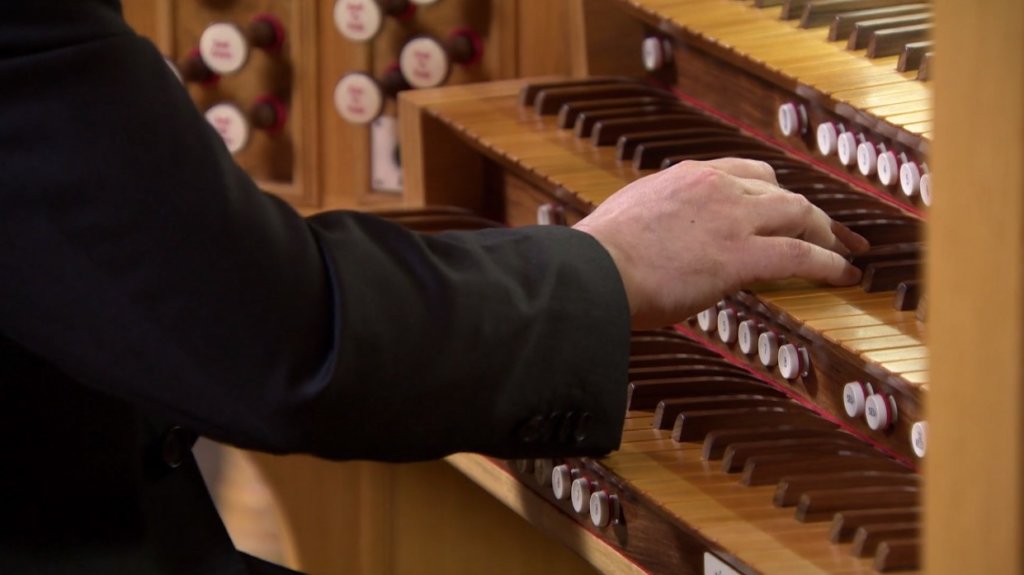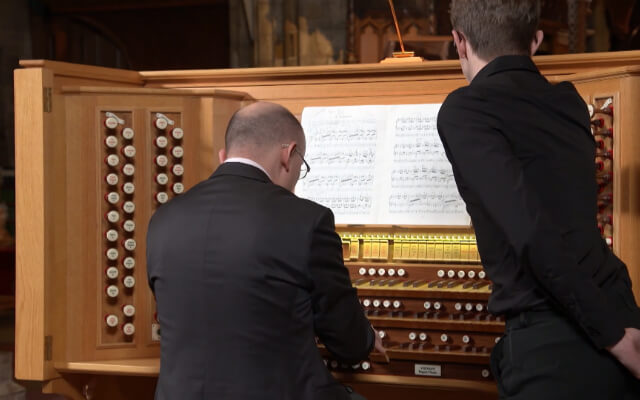Performed at Selby Abbey by Dr Joseph Nolan
When Dr Joseph Nolan recorded tracks at Selby Abbey on a Regent Classic instrument, for our 2017 DVD, he included J.S. Bach’s masterly Partita on the chorale “Sei gegrüsset, Jesu gütig”.
Sei gegrüsset, Jesu gütig: Set of variations on German hymn
The piece (BWV 768) is a set of variations on a German hymn, which starts literally “Greetings, kind Jesus, gentle beyond all measure,” the text of which was published in 1663, and the melody we find here in 1682, according to Peter Williams.
It’s not entirely clear whether the set of variations on this chorale melody was composed as one original sequence, or put together from bits written at different times, as there is apparently no autograph manuscript. (From the player’s point of view, it probably doesn’t matter in any case, but it’s the sort of thing academics tend to fret about a lot.)
What we have in this Partita, though, is a fascinating set of variations exemplifying different formal styles for embellishing the basic theme, employing the theme in various types of counterpoint from a two-part bicinium all the way to a final five-part organo pleno. Rather like the famous Goldberg set, it is something of a masterclass in the playing or writing of contrapuntal variations.
Many of the variations are intended to be played on manuals only, offering plenty of opportunities to experiment with combinations involving flute mutation stops on the choir division.
Joseph Nolan plays Sei gegrüsset on Regent Classic Organ
For his performance of Sei gegrüsset, Nolan starts out with the statement of the main chorale played organo pleno. Organo pleno (literally ‘full organ’, but rarely actually so) is a registration about which more academic discussions have ranged widely. It’s generally agreed to mean the use of some sort of full principal chorus up to at least bright mixtures if you have them.
A 16 foot pedal reed ideally complements the manual registration, as you can hear in this case. (A recent article in Organists’ Review concluded, after a survey of the evidence, that no definitive recipe has survived to indicate what Bach would have included in his organo pleno, and that any formula chosen by the player can be used).
A bicinium follows the chorale, with a gentle eight foot left hand accompanying an embellished melody played on a cornet registration in the right hand. (A cornet is a compound registration of flutes often used for solo lines, incorporating the nazard or twelfth (2 2/3’) and tierce or seventeenth (1 3/5’), which emphasise the odd harmonics and give the cornet its cutting, nasal quality).
Demonstrating deftly that there are no real rules when it comes to registering these variations, Nolan chooses a delicate four-foot flute with which to play the second variation.
The third is played using a so-called ‘gap registration’ in the right hand, whereby a high-pitched stop such as fifteenth or larigot (nineteenth) is used in conjunction with say an eight-foot stop, leaving out some of the harmonics inbetween, giving rise to a glassy tone.
Variation IV is all played on one manual, with the chorale theme sounded simply in the top part, except when it is slightly embellished in the last line, registered on a gentle choir eight foot foundation, with a four foot principal added.

In the fifth variation we have a contrasting situation to the earlier ones, where the interest is in the left hand, all the twiddling around being brought out on an eight-foot reed while the right hand stays quiet and slow on flutes. Here Nolan couples swell reeds to the great to make it more comfortable to play. A great reed might have been too much here.
The sixth variation is then all played on the one choir manual, almost certainly registered as 8, 4 and nazard, giving a slight piquancy to the sound.
This is followed by the seventh variation where the chorale melody is brought out strongly on a 16’ reed in the pedal, accompanied by an organo pleno-style registration for the embellishments in the two hands.
Variation VIII is full of rapid scalic semiquaver movement in the two hands pointed by regular quavers in the pedal. Again Nolan uses a bright gap registration for the hands, all on one manual, this time including the tierce and fifteenth above an eight-foot flute.
The ninth variation is then particularly interesting in employing a four-foot reed in the pedals (a technique often used for baroque chorale preludes where the melody is in the pedals) to sound out the chorale melody high up in the texture. This is accompanied by rapidly moving semiquavers in the hands registered on a widely gapped eight-foot flute plus larigot (1 1/3).
The tenth variation is long and stately, partly because of its elegant and drawn out statement of the chorale theme on solo stops in the right hand, here sounded on both the great solo cornet and an eight foot trumpet to give particular power to the line. This upper line divides in places but despite this tolerates being sounded on powerful solo stops.
This excellent variation leads us into the final and majestic organo pleno verse, where Nolan demonstrates that such a registration can indeed include some serious reeds if the mood calls for it.
What alternative registrations would you use for Sei gegrüsset?
Why not enjoy experimenting with your own alternatives to Joseph Nolan’s registrations, as used in this recording? See if you find that other possibilities work equally well – a decision that will almost certainly depend on the instrument in question, the acoustics, and your taste.
Further reading and related material
- Dr Joseph Nolan plays Regent Classic Skinner Style Organ at Selby Abbey
- Widor’s Symphony for Organ No 5 by Joseph Nolan (Including the famous fifth movement Toccata in F major)
- Regent Classic DVD with Joseph Nolan at Selby Abbey
More videos can also be found on YouTube. Below is a playlist from our channel with the Regent Classic Skinner Organ.
I have had a passion for church organs since the tender age of 12. I own and run Regent Classic Organs with a close attention to the detail that musicians appreciate; and a clear understanding of the benefits of digital technology and keeping to the traditional and emotional elements of organ playing.


